- 1Department of Biology, Plants and Ecosystems, University of Antwerp, Wilrijk, Belgium
- 2Institut for Geology, Center for Earth System Science and Sustainability, Universität Hamburg, Hamburg, Germany
- 3ECOSPHERE Research Group, Department of Biology, University of Antwerp, Wilrijk, Belgium
Enhanced weathering (EW) of silicate rocks is a negative emission technology that captures CO2 from the atmosphere. Olivine (Mg2SiO4) is a fast weathering silicate mineral that can be used for EW and is abundant in dunite rock. In addition to CO2 sequestration, EW also has co-benefits in an agricultural context. Adding silicate minerals to soils can significantly improve crop health and growth as the weathering releases elements such as silicon (Si) that can stimulate crop growth and increase stress resistance, a co-benefit that is becoming increasingly important as global warming proceeds. However, dunite also contains heavy metals, especially nickel (Ni) and chromium (Cr), potentially limiting its use in an agricultural context. In this study, we investigate the influence of dunite addition on growth of barley and wheat in a mesocosm experiment. We amended the soil with the equivalent of 220 ton ha-1 dunite, using two grain sizes (p80 = 1020 µm and p80 = 43.5 µm), under two rainfall regimes (each receiving the same amount of 800 mm water y−1 but at daily versus weekly rainfall frequency). Our results indicate that the amendment of fine dunite increased leaf biomass but only with daily rainfall. Aboveground biomass was significantly reduced with weekly rainfall compared to daily rainfall, but this reduction was slightly alleviated by fine dunite application for wheat. This indicates a positive effect of dunite during drying-rewetting cycles. For barley the negative effect of reduced rainfall frequency was not counterbalanced by dunite application. Contrary to our expectations, calcium (Ca) and Si concentrations in crops decreased with fine dunite application, while, as expected, magnesium (Mg) concentration increased. Coarse dunite application did not significantly affect crop nutrient concentrations, most likely due to its lower weathering rate. In contrast to what was expected, plant Ni and Cr concentrations did not increase with dunite application. Hence, despite high dunite application in our experiment, plants did not accumulate these heavy metals, and only benefited from the released nutrients, albeit dependent on grain size and rainfall frequency.
1 Introduction
Enhanced weathering (EW) of silicate rocks has been proposed as a negative emission technology (NET) to reduce atmospheric carbon dioxide (CO2) concentrations on relatively short timescales, with estimates suggesting that multiple gigatons per year could potentially be sequestered (e.g., Hartmann et al., 2013; Tan and Aviso, 2021). The natural weathering process consumes CO2 and has exerted an important control on atmospheric CO2-concentrations on geological timescales (e.g., Kump et al., 2000). EW aims to speed up this process. This is achieved by applying finely-ground silicates to ecosystems, enhancing the weathering potential compared to the natural background, and thus potentially delivering a major off-set of atmospheric CO2.
With a growing global need for food production, EW is a promising candidate for CO2 removal as it does not compete for land with agriculture, a problem often encountered by other NETs (e.g., afforestation/reforestation or bio-energy with carbon capture and storage) (Beerling et al., 2018; Goll et al., 2021; IPCC, 2022; Janssens et al., 2022). Moreover, potential co-benefits have been identified that could help neutralize multiple adverse human impacts on the soil environment (Amann and Hartmann, 2019; Janssens et al., 2022). The silicate material used for EW typically contains essential plant nutrients. In this way, weathering of silicate minerals such as olivine could potentially improve soil nutrient availability and buffer soil pH (Beerling et al., 2018).
Applying these silicates in agriculture can also improve soil structure and increase water holding capacity (e.g., Beerling et al., 2018; Haque et al., 2019; 2020; Janssens et al., 2022; Swoboda et al., 2022), which could be beneficial under future climate conditions. As climate change progresses, precipitation patterns will change to reduced rainfall frequency, which will lead to longer dry periods followed by heavy precipitation events (IPCC, 2022). This is expected to lead to lower soil water content compared to current conditions (Seneviratne et al., 2010). Decreases in soil water content can reduce weathering rates, which would slow down nutrient release and potentially diminish the positive effects of EW on crop growth (Hartmann et al., 2013).
Olivine is a group of silicate minerals that is often considered for enhanced weathering, especially its magnesium (Mg)-endmember forsterite (Mg2SiO4), because of its widespread availability (Oelkers et al., 2018). Forsterite weathers easily, has the potential to draw down 4 mol of CO2 per mole forsterite weathered, and its dissolution kinetics have been quantified in detail in laboratory experiments (Oelkers et al., 2018). Dunite rock typically contains more than 90% of olivine, hence making it a promising candidate to use for EW (Amann et al., 2020). Carbonic acid (the product of CO2 and H2O) reacts with forsterite during weathering, forming dissolved silicon (H4SiO4), Mg2+-ions and bicarbonate (HCO3−) (Eq. (1)). However, the feasibility of using dunite on agricultural fields depends not only on its CO2-sequestration potential, but also on risks and co-benefits it offers for crops.
Silicon (Si) and Mg are abundant in forsterite, and levels of both elements may increase in both soil and plants with dunite application (Crusciol et al., 2019; Moretti et al., 2019). Si fertilization can be essential for crop health and production. In long-term cultivated land, soils are often depleted in bio-available Si pools (e.g., Meunier et al., 2008), due to the long-term harvest of Si-accumulating crops, e.g., wheat, rice, sugarcane, grass and maize (e.g., Vandevenne et al., 2012), exporting reactive Si from soils. In fact, several of the most important crops for food production belong to the Poaceae family, which are known accumulators of Si (Datnoff et al., 1997).
Si can improve the ability of plants to cope with reduced rainfall frequency in several ways. First, increasing Si availability has been reported to enhance water use efficiency, which can improve mineral uptake during dry periods (Eneji et al., 2008; Neu et al., 2017; Bhardwaj and Kapoor, 2021; Johnson et al., 2022; Sogarwal et al., 2022). Second, Si helps to regulate photosynthesis in various ways (Maghsoudi et al., 2016) and it can facilitate water uptake by influencing the osmotic potential of plants (Khattab et al., 2014; Bhardwaj and Kapoor, 2021). Therefore, silicate minerals could aid in agricultural climate adaptation as Si fertilizer, as rainfall frequency is likely to reduce in the future.
Besides Si, Mg is also abundant in dunite. The importance of Mg for plant nutrition is often overlooked, even though Mg deficiency may lead to plant growth inhibition, acceleration of aging and reduced productivity and quality in agriculture (Gransee and Führs, 2013; Guo et al., 2015). Because of its competition with other ions, especially calcium (Ca) and potassium (K), to be taken up by plant roots, unbalanced crop fertilization leads to Mg depletion and leaching, hence causing Mg deficiency in plants (Guo et al., 2015). Mg deficiency is also a problem for parts of the human population (Guo et al., 2015), further emphasizing its importance in food production.
Even though the use of dunite for CO2 sequestration has been documented in several studies (e.g., ten Berge et al., 2012; Dietzen et al., 2018; Amann et al., 2022), few have evaluated its effect on plant growth and nutrient content. Nonetheless, ten Berge et al. (2012) identified a potential positive effect of olivine addition on the growth of Lolium perenne. Plant growth increased by about 15%, but only at a high olivine addition rate of 220 ton ha-1 in a sandy soil with low ambient Si availability. Similarly, increased plant growth upon dunite addition was also found in soybean (Moretti et al., 2019) and corn (Crusciol et al., 2019). In both studies, the Mg and Si concentrations in the leaves increased with increasing dunite concentration. ten Berge et al. (2012), however, found that high olivine addition increased nickel (Ni) concentrations in the plants and recommended to study its application to different types of crops for a more comprehensive assessment of risks associated with olivine-derived Ni. Such assessments should also include other metals that occur in dunite, such as barium (Ba), cobalt (Co), strontium (Sr) and zinc (Zn).
Laboratory experiments have shown that weathering rates typically increase with decreasing grain size (e.g., Hartmann et al., 2013). Therefore, using smaller grain sizes may result in even greater increases in nutrient availability in soils amended with dunite. However, Amann et al. (2020) observed higher weathering rates for coarse than for fine dunite, and stressed that weathering rates in soils may differ substantially from those under ideal conditions in the laboratory. Accordingly, effects on nutrient availability and plant growth can deviate from what is theoretically expected. Moreover, water availability is a key driver of weathering rates (Calabrese et al., 2017; Edwards et al., 2017; Cipolla et al., 2021), but experimental data is missing on the interaction effect between dunite application and altered precipitation.
Here, we report results from a full-growing season mesocosm experiment investigating the influence of coarse and fine dunite addition on barley and wheat growth, nutrient and heavy metal cycling, and how this dunite effect varies under different rainfall frequency treatments (daily and weekly frequency, with the same amount of total rainfall). Previously, Amann et al. (2022) reported the effects of this experiment on soil chemistry and estimated a CO2 consumption of 2.3–4.9 t CO2 km-1 y-1 with dunite application based on Mg2+ fluxes. They had also found that Si in the soil pore water increased with coarse dunite application, and decreased with fine dunite application, presumably due to formation of a secondary Si-rich layer. Increases in pore water pH, Mg and dissolved inorganic carbon (DIC) were most pronounced with fine dunite application. Porewater Ni concentrations were elevated with both dunite grain sizes, while chromium (CR) concentrations only when fine dunite was applied. Soil chemistry was unaffected by differences in rainfall frequency.
We hypothesize that: I) Both dunite treatments will increase dry weight biomass compared to the control with higher nutrient concentrations (especially Mg and Si) and that this effect will be larger under the fine dunite treatment compared to the coarse dunite treatment; II) Dunite treatments will increase heavy metal concentrations in all plant parts, especially with fine dunite application; III) Weathering rates will be higher with daily rainfall compared to weekly rainfall and this will exacerbate the dunite effects expected in hypotheses I and II; IV) Weekly rainfall will reduce plant growth and nutrient uptake in contrast to daily rainfall. This negative effect of reduced rainfall is expected to be counterbalanced by dunite application.
2 Materials and methods
2.1 Experimental setup
A full-factorial mesocosm experiment with two grain sizes of dunite, two rainfall regimes (daily and weekly rainfall) and two crop species (barley and wheat), with five replicates per treatment, started in October 2013 in a greenhouse and ran for 234 days (see also Amann et al. (2020), who reported on soil chemistry and carbon sequestration results from this mesocosm experiment). Crops were sown on 2013–10–21 (day 0), barley was harvested on 2014–06–02 (day 224) and wheat on 2014–06–12 (day 234). Rain barrel mesocosms (diameter of 46 cm) were filled with a natural loamy sandy soil (pH-KCl = 6.6) from Belgium (detailed characterization including grain size distribution in Supplementary Table S1). Two different dunite grain size fractions (coarse with p80 = 1,020 μm, and fine with p80 = 43.5 µm, henceforth referred to as coarse and fine dunite treatment, respectively) (p80 = sieve mesh at which 20% is retained and thus 80% is smaller than the given diameter) were tested by applying olivine-rich dunite in the top 20 cm of the soil with a concentration of 220 t ha-1 (a high mass to induce observable effects, and a similar value as the maximum mass applied in an experiment by ten Berge et al., 2012). A treatment was also included where no dunite was applied (henceforth referred to as control treatment).
Each dunite treatment was set-up for two crop species (barley and wheat). Each dunite and crop combination was exposed to two irrigation regimes (daily and weekly precipitation), while the total amount of water was equal (about 800 mm y−1, which corresponds to the mean annual precipitation in Belgium) (Figure 1). Commercial nitrogen (N) fertilizer (100 kg ha-1) was added on 2014–01–01, 2014–02–10, 2014–03–14 and 2014–04–23. Fungicide (Compo Duaxo, foliar application) was used twice during the experiment on 2014–01–30 and 2014–04–23. Meteorological conditions (relative humidity, temperature and irradiance) are given in Supplementary Table S2.

FIGURE 1. Impression of the experiment. Top row is barley, middle row is wheat and bottom row is a general overview. From left to right are different stages of crop growth starting 1 day after sowing (left) and ending 1 day after harvesting (right).
2.2 Dunite
Dunite from Norway was used, containing approximately 90% olivine, of which 92% was forsterite. Minor occurrences of lizardite, Cr-bearing minerals, chabazite and Mg hornblende were found. More insights into the geochemistry, bulk density and particle size distribution of the material can be found in Amann et al. (2020).
2.3 Sampling
A set amount of rainwater, collected in a tank next to the greenhouse was given to each container over the week (set by the automated sprinklers) and was verified by a pluviometer. A storage underneath the soil was emptied every 2 weeks through a tap. The seepage water volume was measured. The difference between the volume of water given and the volume of water measured in the storage after seeping through the soil gives the amount of water that is retained by the soil or lost by evapotranspiration. Differences in this water balance between blanks and containers with crops give an indication of the share of water that is evaporated (no transpiration in blanks) and transpired by the crops (Supplementary Table S3). Water from both pluviometers was analyzed for nutrients (NH4, NO3 and PO4) monthly (Table 1). Porewater was sampled on six occasions during the experiment (2013–10–28, 2013–11–13, 2013–12–9, 2014–01–06, 2014–02–05, 2014–03–14) and pH was measured (WTW, Weilheim, Germany). At the beginning of the experiment, initial soil pH was measured directly in the soil with a pH meter (IQ150, Spectrum Technologies, Aurora, United States). Soil samples were taken from the top 10 cm when the plants were harvested. Cation exchange capacity (CEC) of the soil samples was measured according to Brown (1943), with 1M ammonium acetate buffered at pH 7 serving as the extractant.

TABLE 1. Concentration of PO4, NH4, NO2 and NO3 in the rain water. Values are averages of two pluviometers with standard deviation (stdev).
Plant growth was monitored by measuring the five longest shoots per container from the soil to the tip of the longest leaf (hereafter referred to as shoot length) on six different timepoints during the experiment. Growth rate was then calculated (Eq. (2)) with L2 the length measured on timepoint T2 and L1 the length measured at timepoint T1.
The first seedlings appeared in April and crops were ready for harvest in the beginning of June 2014. All shoots per container were cut into pieces to separate stems, leaves, culms (without grains), grains and litter (dead leaves that had fallen on the soil). Stems were counted and their length was measured. The number of culms was counted too. All samples were dried at 70°C for 72 h and weighed to determine dry mass (DM) per plant part. Samples were homogenized by grinding and subsamples were analyzed for various elements (see below).
2.4 Chemical analyses
N, phosphorous (P), K, Mg and Ca content were determined in plant samples according to Walinga et al. (1989): digestion of the subsamples was performed with H2SO4, salicylic acid, H2O2 and selenium and analyzed on a colorimetric segmented flow analyzer (SAN++, Skalar, Breda, Netherlands). To determine Si content, 25 mg subsamples were incubated in 25 mL 0.5 M NaOH at 80°C for 5 h. The extracted and dissolved Si was analysed colorimetrically on a segmented flow analyser (SAN++, Skalar, Breda, Netherlands). The extraction in 0.5 M NaOH at 80°C has been well established and tested; it is capable of fully dissolving the Si from plant phytoliths at the solid-solution ratio and extraction time we applied (Saccone et al., 2007).
To determine concentrations of aluminum (Al), Ba, Cr, Co, iron (Fe), Ni, Sr, and Zn, plant samples were dried at 105°C and approximately 150 mg was used for analysis. In Teflon cups, 4 mL of HNO3 (65%), 3 mL of HF (40%) and 2 mL of HClO4 (70%) were added after which the samples were left overnight to react. Afterwards the samples were digested at 170°C for 10 h. The remains were dissolved in 0.6 mL HCl (30%) and 1 mL HBO3 and 10 mL water at 60°C for 1 h. The samples were then transferred to vials for measurements. Per series, one blind and one reference sample were analyzed with an inductively coupled plasma atomic emission spectroscopy (ICP-AES, Optima 2,100, PerkinElmer).
2.5 Statistical analyses
All statistical analysis were performed in R (Rstudio, 2021.09.0.0). The level of significance p for all the tests was ≤0.05. Whenever concentrations of an analyte were below the LOQ (limit of quantification) in >80% of the samples, it was excluded from analyses. The litter and culm biomass were used for calculating the total biomass of the whole plant, but were excluded from further analysis. Data normality of residuals and homoscedasticity were checked using the Shapiro–Wilk test and the Breusch-Pagan Test using the lmTest package (Kuznetsova et al., 2017), respectively. When assumptions were not met, a log-transformation or box-cox was used to increase normality or homoscedasticity. Plots were made using the ggplot2 package (Wickham, 2016), ggpubr package (Kassambara, 2023) and the Rmisc package (Hope, 2022).
To test for significant differences in growth rate and shoot length over time, a linear mixed effect model was performed with dunite treatment, rainfall treatment, crop species and time and their interactions as fixed effects and mesocosm as random effect, using the nlme package (Pinheiro et al., 2023). The weights = varIdent component was incorporated into the model to account for heteroscedasticity in the data across different time points and accommodate the varying levels of uncertainty in the response variable associated with different time conditions. When the four-way interaction was significant, the same model was applied for both crops separately, without crops as a fixed effect hence decreasing the complexity. Backward stepwise selection was used to compose the best model.
A three-way ANOVA was performed to investigate the significance of the differences in plant biomass, nutrient concentrations and metal concentrations at the end of the experiment among the different dunite treatments, between the two rainfall treatments and the two crops, and their three-way interaction effect. When a three-way interaction occurred, a two-way ANOVA was performed for each crop species separately to look for two-way interaction effects of dunite and rainfall treatment. Backward stepwise selection was used to compose the best model. When ANOVA indicated significant treatment effects, a Tukey post hoc analysis was performed to compare groups.
3 Results
3.1 Plant growth rate and biomass
Both plant growth rate and shoot length during the experiment showed a significant four-way-interaction among dunite treatment, rainfall treatment, crop species and time (Supplementary Table S4). Therefore, the influence of rainfall treatment and dunite treatment over time on growth rate and shoot length were investigated for both crops separately.
For barley, a significant three-way interaction was found among dunite treatment, rainfall treatment and time on growth rate. From day 150 onward, under the weekly rainfall treatment, a lower growth rate was observed when fine dunite was applied compared to the coarse dunite and control treatment. Under the daily rainfall treatment, no differences in barley growth rate among dunite treatments were observed. Growth length of wheat showed a significant two-way interaction effect between rainfall treatment and time, as well as between dunite treatment and time. Towards the end of the experiment, wheat growth rate declined with coarse dunite application compared to the fine dunite and the control treatment. However, this was only observed under the weekly rainfall treatment (Table 2; Figure 2). The average shoot length of wheat showed a significant three-way interaction among dunite and rainfall treatments over time (Table 2). Starting from day 150, wheat shoot length was higher under the fine dunite treatment compared to the control and coarse dunite treatment, but only under the weekly rainfall treatment. Conversely, there were no significant differences in barley shoot length among the different dunite treatments. The rainfall treatment did show a significant interaction with time (Table 2), with a lower shoot length under the weekly compared to the daily rainfall treatment towards the end of the experiment (Figure 3).

TABLE 2. Statistical significance (p- and F-values) of the effect of dunite treatment (fine dunite, coarse dunite or no dunite), rainfall treatment (daily rainfall or weekly rainfall) over time and their interactions on shoot length and growth rate of barley and wheat, separately. Non-significant interactions were excluded from the statistical model and are shown in the table as ns. Statistical significance is indicated with an asterisk (*).
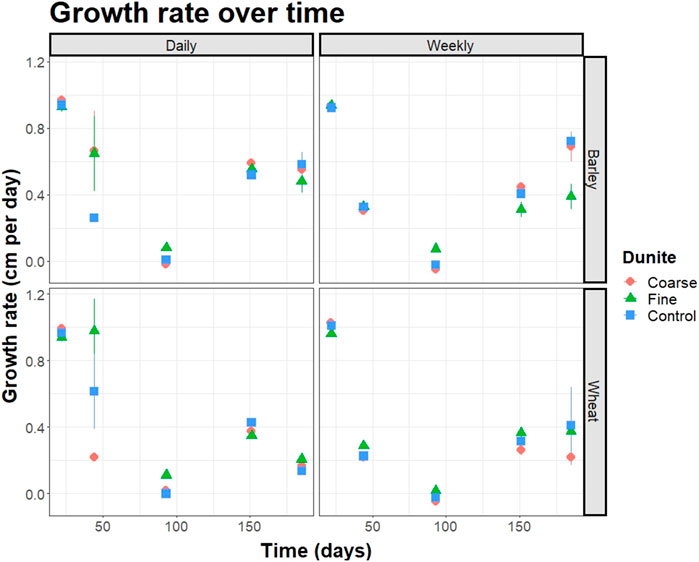
FIGURE 2. Growth rate of barley and wheat per rain treatment (daily or weekly rainfall) for the three dunite treatments (coarse, fine or no dunite) during the experiment. Data are averages of 5 replicates with standard error. Note that in some cases, error bars are smaller than the symbol. Results of the statistical analyses are reported in Table 2.
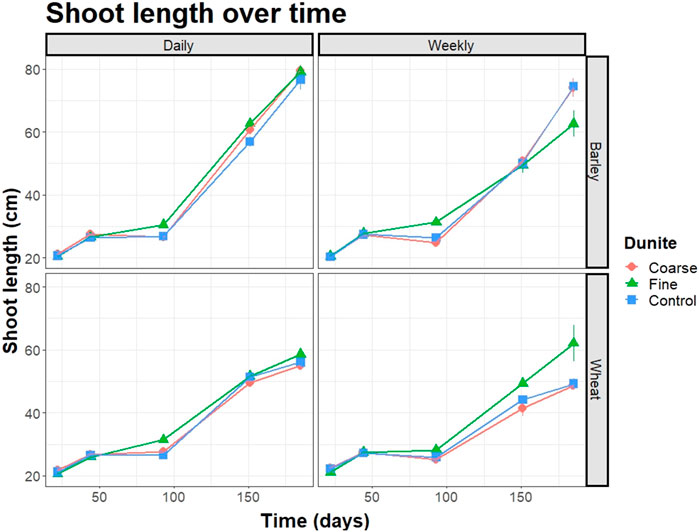
FIGURE 3. Average shoot length of barley and wheat per rainfall treatment (daily or weekly rainfall) for the three dunite treatments (coarse, fine or no dunite) during the experiment. Data are averages of 5 replicates with standard error. Note that in some cases, error bars are smaller than the symbol. Results of the statistical analyses are reported in Table 2.
A three-way interaction trend was found for total aboveground biomass (Table 3). Barley biomass was significantly lower with weekly compared to daily rainfall (p < 0.01, F = 35), while barley biomass did not differ among dunite treatments (p = 0.68, F = 0.39). In contrast, wheat biomass was significantly lower with weekly rainfall compared to daily rainfall, but only for the coarse dunite and the control treatments. With fine dunite application, this reduction in biomass was not significant (Supplementary Table S5A, Figure 4).
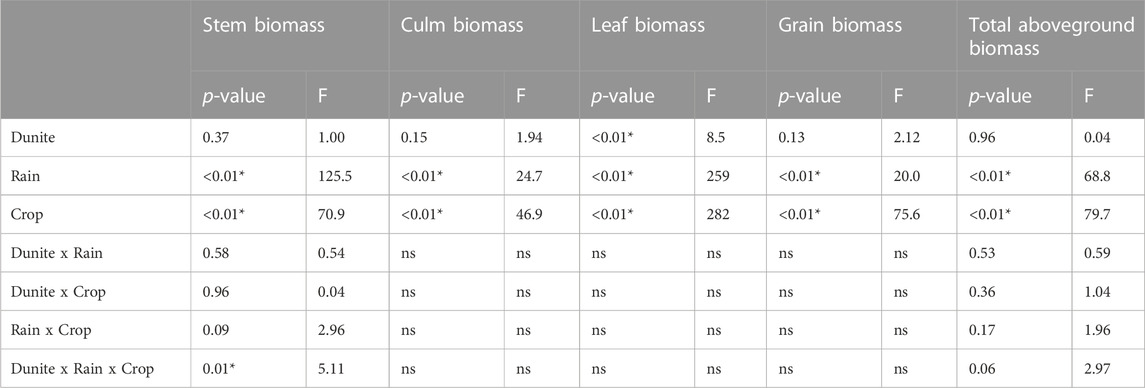
TABLE 3. Statistical significance (p- and F-values) of the effect of dunite treatment (fine dunite, coarse dunite or no dunite), rainfall treatment (daily rainfall or weekly rainfall) and crop species (barley or wheat) on the stem, culm, leaf and grain biomass. Non-significant interactions were excluded from the model and are shown in the table as ns. Statistical significance is indicated with an asterisk (*).
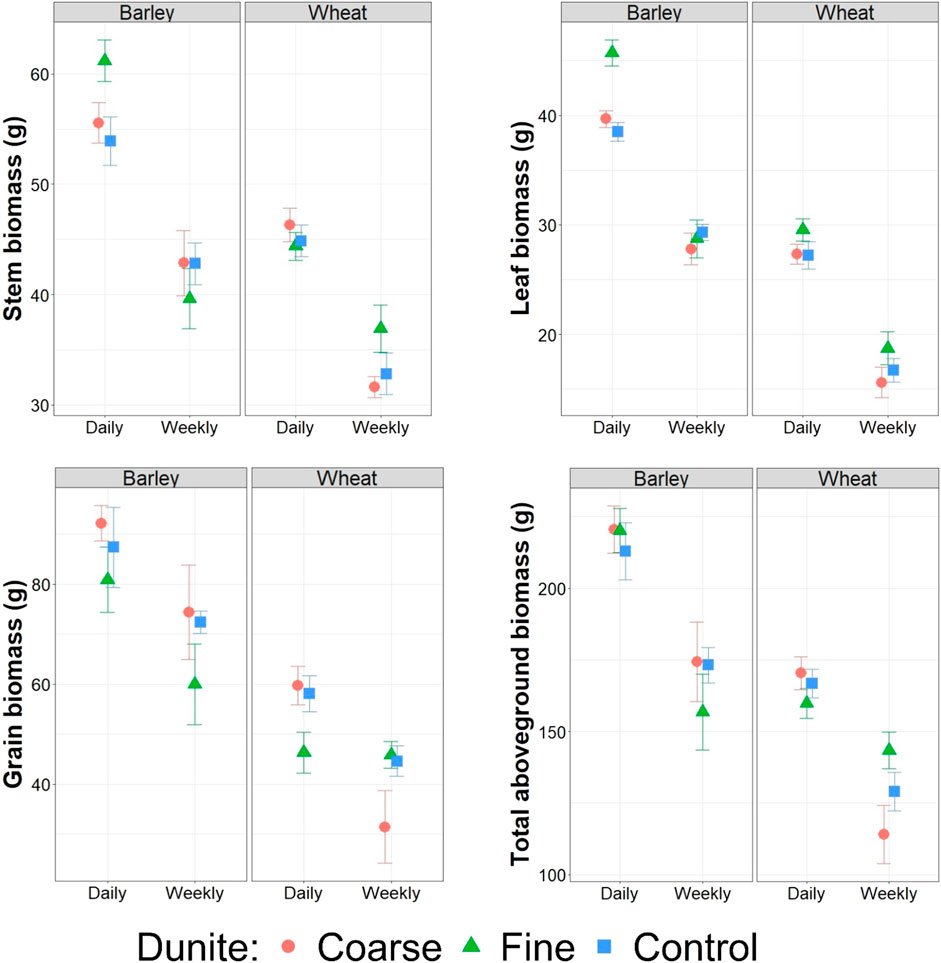
FIGURE 4. Stem, leaf and grain biomass separately, and total above ground biomass at the end of the experiment for barley and wheat under different rainfall (daily or weekly rainfall) and dunite treatments (coarse, fine or no dunite). Data are averages of 5 replicates with standard error. Results of the statistical analyses are reported in Table 3.
A significant three-way interaction effect was observed for stem biomass (Table 3). The rainfall treatment significantly influenced stem biomass of barley (p < 0.01, F = 63.9) as well as wheat (p < 0.01, F = 63.4), while dunite did not (p = 0.7 and F = 0.47 for barley, p = 0.5 and F = 0.62 for wheat) (Figure 4). Reduced stem biomass under weekly rainfall compared to daily rainfall treatment was more pronounced for barley than for wheat. Leaf biomass differed significantly among dunite, rainfall and crop treatments (Table 3). Fine dunite treatment resulted in higher leaf biomass compared to the coarse and control treatments (p < 0.01). Additionally, the weekly rainfall treatment reduced leaf biomass significantly compared to the daily rainfall treatment (p < 0.01). Wheat leaf biomass was significantly lower than that of barley (p < 0.01) (Figure 4).
A large variation in grain yield was observed and the addition of dunite did not influence the grain biomass of both crops (Table 3; Figure 4). Similar stem lengths were observed for both crops, regardless of the dunite treatment or rainfall treatment (Table 4; Figure 5), but the number of stems and culms of both crops were significantly higher under the daily rainfall treatment than with weekly rainfall (Table 4; Figure 5). Accordingly, grain and culm biomass were higher under the daily than under the weekly rainfall treatment, and this remained unaffected by dunite application (Table 3; Figure 4).
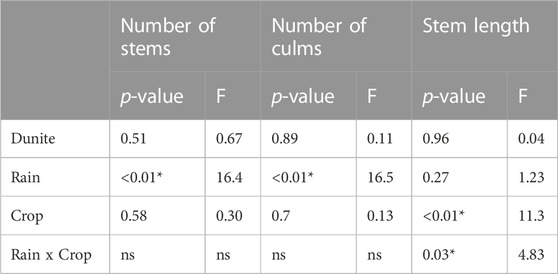
TABLE 4. Statistical significance (p- and F-values) of the effect of dunite treatment (fine dunite, coarse dunite or no dunite), rainfall treatment (daily rainfall or weekly rainfall) and crop species (barley or wheat) on the number of stems, number of culms and stem length. Interactions were all not statistically significant (p > 0.05) and therefore excluded from the model and the table. Statistical significance is indicated with an asterisk (*).
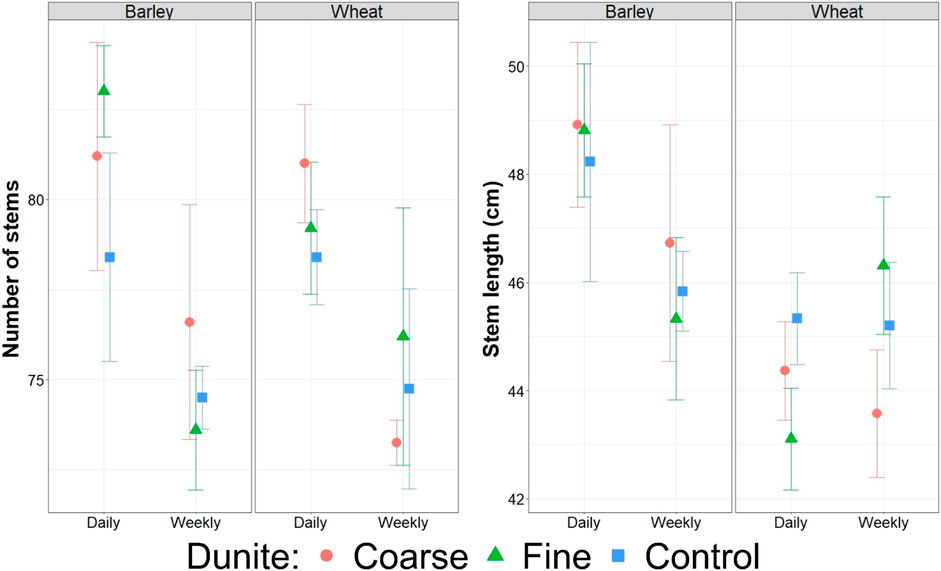
FIGURE 5. Number of stems and stem length at the end of the experiment for barley and wheat under different rainfall (daily or weekly rainfall) and dunite treatments (coarse, fine or control). Data are averages of 5 replicates with standard error. Results of the statistical analyses are reported in Table 4.
3.2 Nutrients
The influence of dunite addition on Si concentrations in stems and leaves varied between fine and coarse dunite treatments. Fine dunite significantly decreased Si concentrations, whereas no effect was observed under the coarse dunite treatment (Table 5; Figure 6). In grains, a three-way interaction between dunite treatment, crop species and rainfall treatment was found (Table 5; Figure 6). Wheat grain Si concentrations were similar among the dunite and rainfall treatments, while in barley grains, a significant interaction effect was detected between dunite and rainfall treatment (p = 0.01, F = 5). Si concentrations were significantly lower under the fine dunite treatment compared to the coarse with weekly rainfall (p < 0.01), whereas with daily rainfall, barley grain Si concentrations did not differ among dunite treatments (Supplementary Table S5B, Figure 6). Similar to Si, Ca concentrations in stems, leaves and grains decreased under the fine dunite treatment, but not under the coarse dunite treatment. This decrease was influenced by crop species with a larger effect observed in stems and leaves of barley compared to stems and leaves of wheat (Table 5; Figure 6).
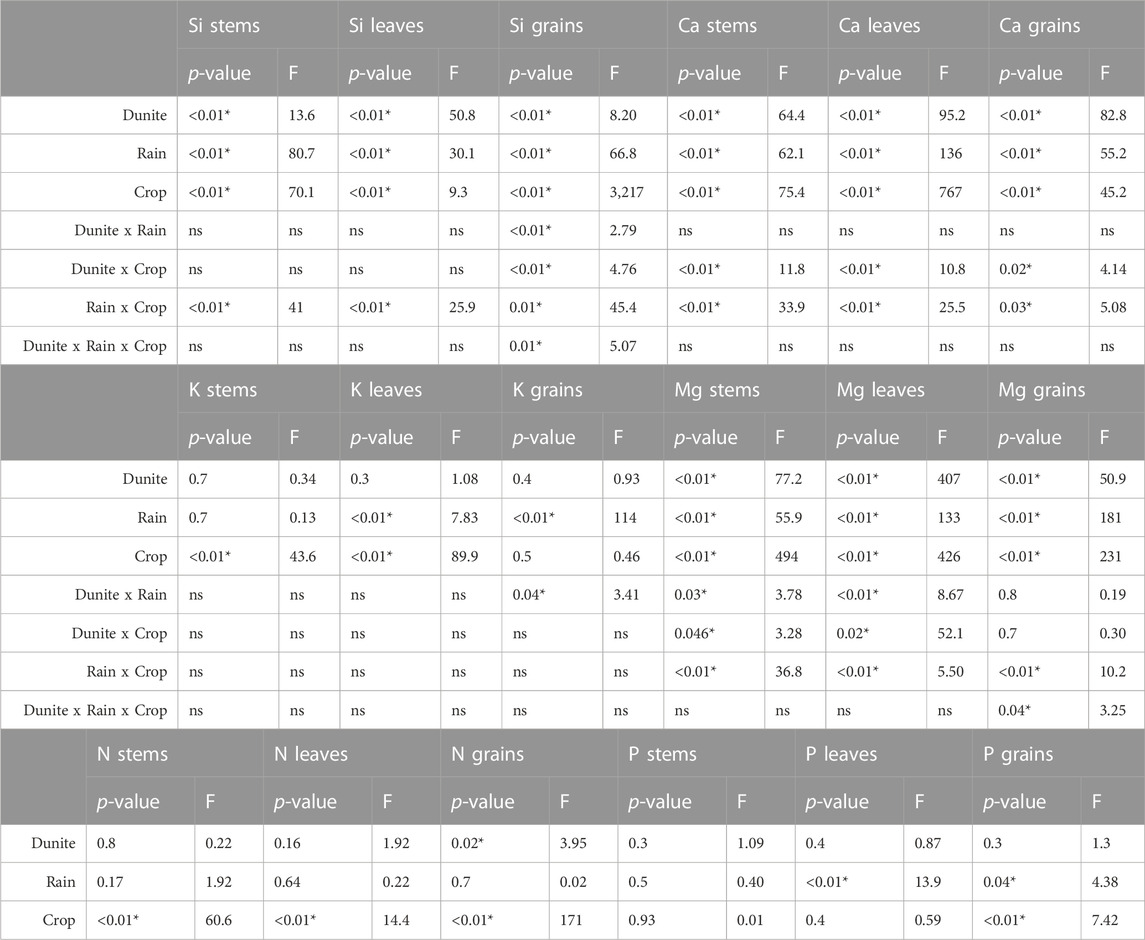
TABLE 5. Statistical significance (p- and F-values of the effect of dunite treatment (fine dunite, coarse dunite or no dunite), rainfall treatment (daily rainfall or weekly rainfall) and crop species (barley or wheat) on the different nutrients (Si, Ca, K, Mg, N and P) in stems, leaves and grains. When interactions were not significant, they were excluded from the model and are shown as ns. Interactions were not significant for N and P and are therefore excluded from the table. Statistical significance is indicated with an asterisk (*).
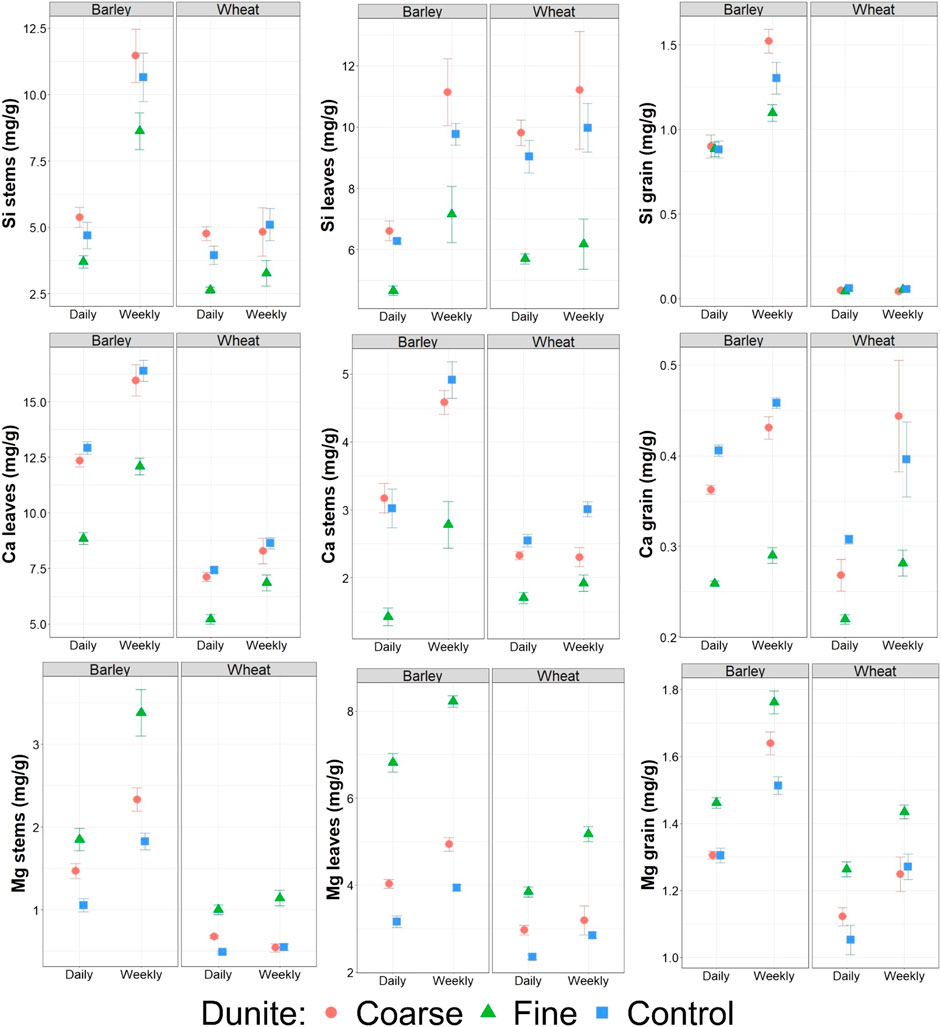
FIGURE 6. Concentrations of Si, Ca and Mg in stems, leaves and grains of barley and wheat under different rainfall (daily or weekly rainfall) and dunite treatments (coarse, fine or no dunite). Data are averages of 5 replicates with standard error. Note that in some cases, error bars are smaller than the symbol. Results of the statistical analyses are reported in Table 5.
In contrast to Si and Ca, the addition of both fine and coarse dunite increased Mg concentrations in stems, leaves and grains. Leaves and stems showed a two-way interaction between dunite and rainfall, and between dunite and crop species (Table 5; Figure 6). Both daily and weekly rainfall increased leaf Mg concentrations under fine and coarse dunite treatments compared to the control, with a more substantial increase with fine dunite addition. Fine and coarse dunite addition increased leaf Mg concentrations, with a greater effect for the fine dunite application in barley compared to wheat (Table 5; Figure 6). Stem Mg concentrations increased with fine and coarse dunite application for both crops with daily rainfall, while with weekly rainfall, only fine dunite application increased stem Mg concentrations (p < 0.01) (Table 5; Figure 6). Additionally, the increase in Mg concentrations was larger for barley compared to wheat (Figure 6).
A three-way interaction effect and of dunite treatment, rainfall treatment and crop species on grain Mg concentrations was observed (Table 5; Figure 6), with higher Mg concentrations for barley than for wheat. While the addition of coarse dunite did not significantly affect grain Mg concentrations, the application of fine dunite resulted in a significant increase in grain Mg concentrations for both crop species under both rainfall treatments (Supplementary Table S5C, Figure 6).
A significant interaction between dunite and rainfall treatment was observed in grain K concentrations (Table 5; Figure 7), which were significantly higher under weekly than under daily rainfall. This increase was more pronounced under the coarse dunite treatment (Table 5; Figure 7). Grain N concentrations were significantly higher with fine compared to coarse dunite addition. However, neither of the dunite treatments differed significantly from the control treatment. There were no other statistically significant effects of dunite addition on N, K or P concentrations in the grains (Figure 7) and other plant parts (Table 5).

FIGURE 7. Concentrations of N, P and K in grains of barley and wheat under different rainfall (daily or weekly rainfall) and dunite treatments (coarse, fine or no dunite). Data are averages of 5 replicates with standard error. Results of the statistical analyses are reported in Table 5.
3.3 Trace metals in plants
The concentrations of Ni, Co and Cr in plants were below the LOQ (1.0 μg g-1 for Ni, 1.0 μg g-1 for Co and 1.5 μg g-1 for Cr) in over 80% of the samples. In the grains, which represent the commercially most important part of the crops, the concentrations of Ni, Co and Cr were all below the LOQ. Cr was only detected in stems (once under the control and twice under the coarse dunite treatment) and in leaves (four times under the control, four times under the coarse dunite treatment and once under the fine dunite treatment) with a maximum of 10.1 mg kg-1. Among the plant parts, statistical analysis could only be performed for wheat leaves concerning Cr concentrations. However, no significant influence of the dunite treatments was observed. Ni was detected in only one sample, in wheat stems under the coarse dunite treatment under the daily rainfall regime, with a value of 4.9 μg kg-1.
Both fine and coarse dunite treatments had an impact on Ba and Sr, but not on Al, Fe and Zn concentrations in the crops (Table 6; Figure 8). Ba concentrations were negatively influenced by dunite addition with a significant reduction in the leaves under the fine dunite compared to the control and coarse dunite treatments. A similar pattern was observed for Ba concentrations in the stem, although the fine dunite treatment differed significantly only from the coarse dunite, not from the control (Figure 8). Ba grain concentrations were >LOQ (1 μg g-1) in only 12% of the samples (Supplementary Table S6).
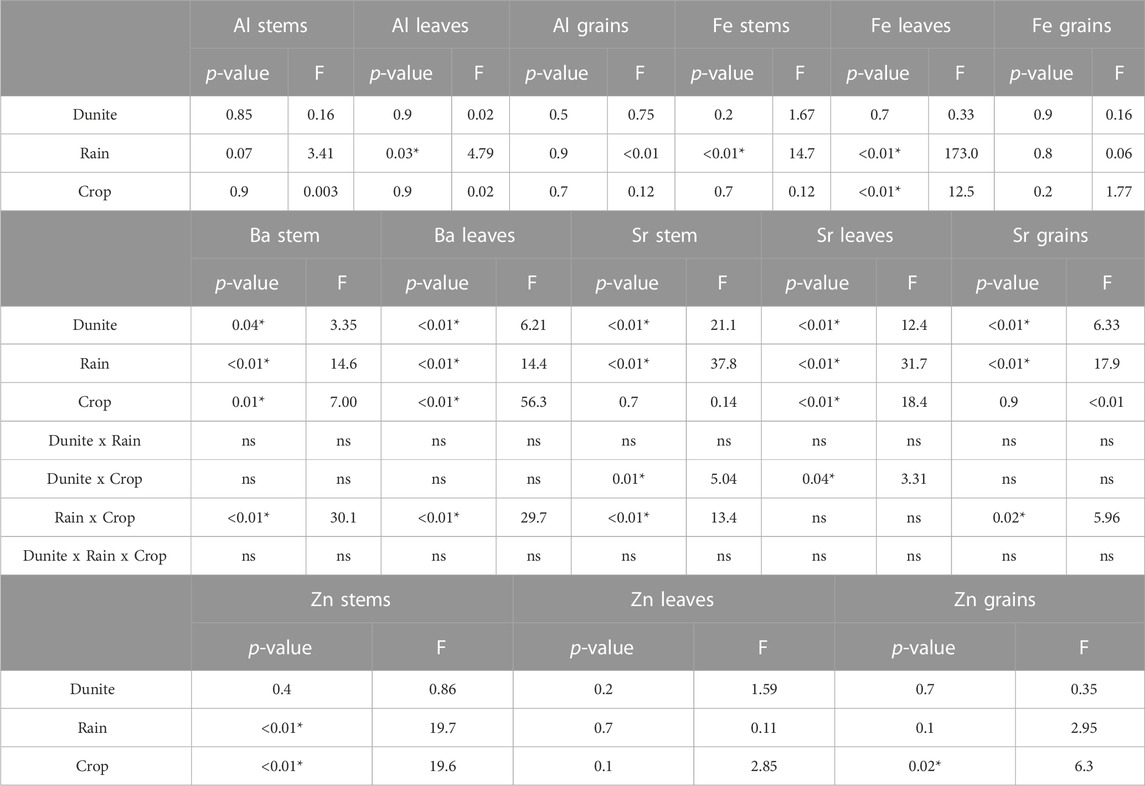
TABLE 6. Statistical significance (p- and F-values) of the effect of dunite treatment (fine dunite, coarse dunite or no dunite), rainfall treatment (daily rainfall or weekly rainfall) and crop species (barley or wheat) on the different trace metals (Al, Ba, Fe, Sr and Zn) in stems, leaves and grains. When interactions were not significant, they were excluded from the model and are shown as ns. Interactions were not significant for Al, Fe and Zn and are therefore excluded from the table. Statistical significance is indicated with an asterisk (*).
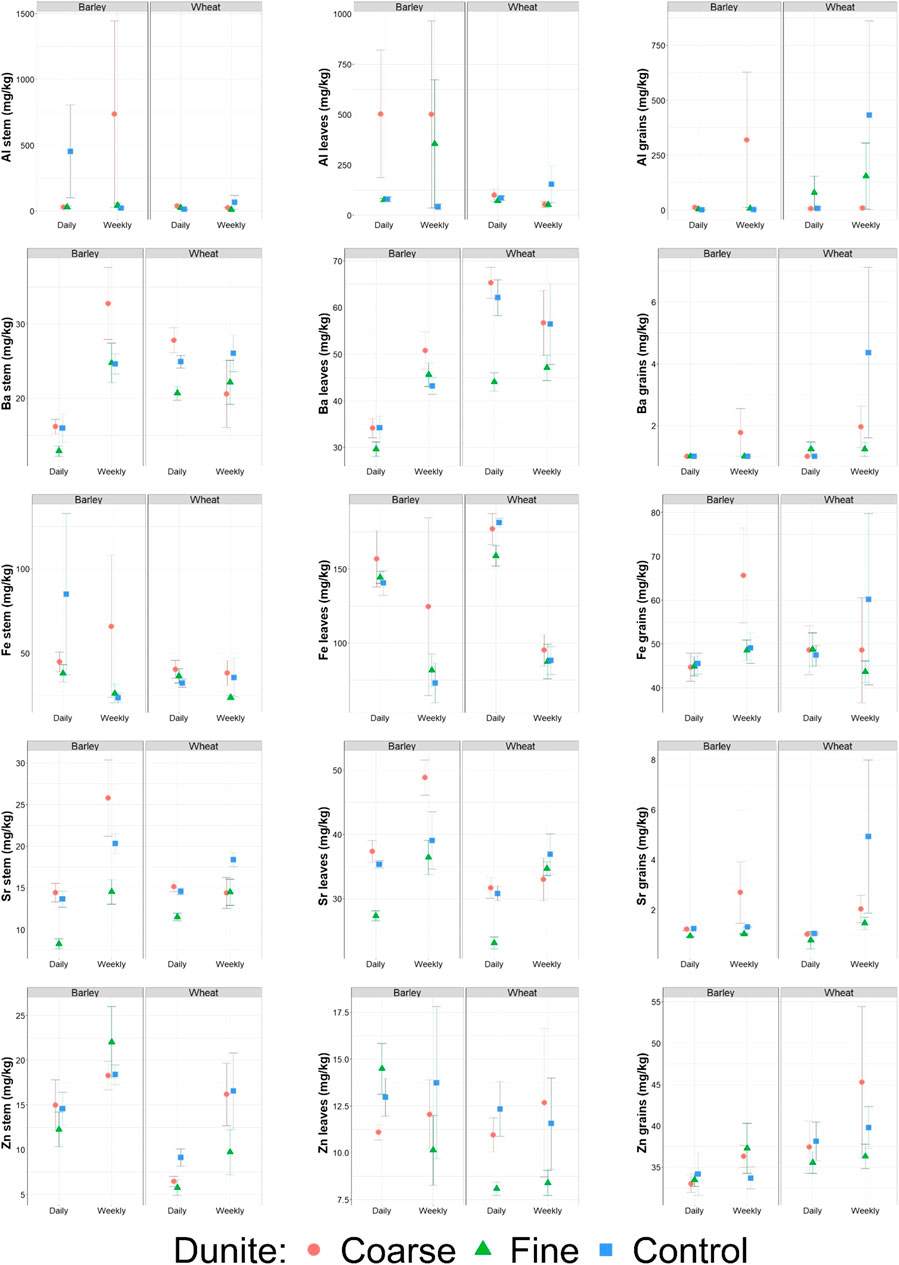
FIGURE 8. Concentrations of Al, Ba, Fe, Sr and Zn in stems, leaves and grains of barley and wheat under different rainfall (daily or weekly rainfall) and dunite treatments (coarse, fine or no dunite). Data are averages of 5 replicates with standard error. Note that in some cases, error bars are smaller than the symbol. Results of the statistical analyses are reported in Table 6.
Similarly, Sr concentrations were negatively affected by dunite addition, although this effect differed between crops (Table 6; Figure 8). Besides lower stem Sr concentrations under the fine compared to the coarse dunite treatment, fine dunite addition significantly reduced stem Sr concentrations for both crops compared to the control. Dunite addition did not show any influence on wheat leaves Sr concentrations, while it significantly decreased Sr concentrations in barley leaves. Grain Sr concentrations significantly decreased under the fine dunite treatment, which was consistent for both crops. The influence of dunite addition on trace metals in plant parts was not affected by rainfall treatment (table 6).
4 Discussion
4.1 Benefits of dunite application for crops
The application of fine dunite positively affected leaf biomass of both crops and average shoot length of wheat. Even though a lower growth rate was observed for barley with fine dunite application under the weekly rainfall treatment, average shoot length and biomass of the plant parts were not negatively affected by dunite application. Previous studies have also shown increases in shoot dry matter in corn (Crusciol et al., 2019) and in soybean (Moretti et al., 2019) as well as improved grain yield for both crops. Similarly, ten Berge et al. (2012) observed an increase of ryegrass biomass with the same amount of olivine as used in this study. Even though leaf biomass increased with fine dunite application, it did not have a significant effect on biomass of other plant parts, nor on grain yield. This lack of impact on grain yield might be related to effects on availability of essential nutrients, which varied substantially among different elements.
Nitrogen is a key nutrient for plant growth, as it is a primary constituent of nucleotides and proteins (Xu et al., 2012). In our study, fine dunite treatment showed higher grain N concentrations compared to coarse dunite. N fertilizer was added in this experiment, however this was done in equal amounts for each pot. Therefore, differences among treatments could be attributed to dunite application. As dunite does not contain N, the higher N concentrations are most likely due to indirect dunite application effects. Presumably, dunite application stimulated mineralization more under the fine dunite treatment. Mineralization liberates N from organic matter thereby increasing its availability to plants. The process of mineralization is pH-dependent (Pietri and Brookes, 2008), and the higher soil solution pH with the fine dunite application compared to the coarse dunite application (Figure 9) likely contributed to increased N availability. While N concentrations increased, P concentrations were not affected by dunite application, which was expected as dunite only contains a small amount of P. Even though dunite weathering may have released a small amount of P, the rise in soil solution pH (Figure 9) along with increased Ca concentrations likely immobilized P, what counteracts potential P release by dunite weathering (Bose and Satyanarayana, 2017).
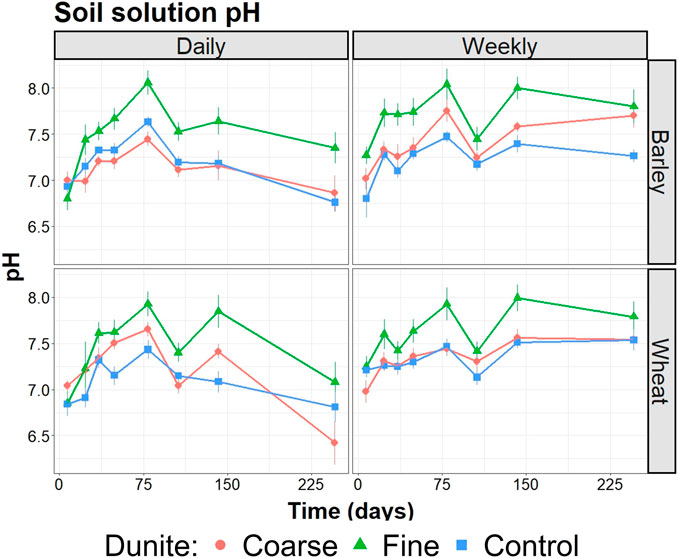
FIGURE 9. Soil solution pH during the experiment for barley and wheat under different rainfall (daily or weekly rainfall) and dunite treatments (coarse, fine or no dunite). Data are averages of 5 replicates per timepoint measured with standard error.
In contrast to N, P and K, dunite addition clearly changed plant Mg, Ca and Si concentrations. Ca concentrations in all plant parts decreased by fine dunite addition. Plants acquire Ca from the soil solution, and its uptake depends on the concentration of other divalent cations present in the soil solution (Marschner, 2011). As Mg is abundant in dunite and its weathering releases a substantial amount of Mg, the higher weathering rate of fine dunite led to increased Mg concentrations in the pore water (Amann et al., 2020), stimulating plant Mg uptake. However, due to competition for plant binding sites with Ca, the increased Mg concentrations in the soil solution likely reduced Ca uptake, resulting in lower Ca concentrations in the plant parts under the fine dunite treatment. A similar trend was also found in rye grass by ten Berge et al. (2012).
Si concentrations decreased in the different plant parts under the fine dunite treatment, while the coarse dunite treatment did not have a significant effect on Si concentrations. This corresponds with the observations in the soil solution, where a decrease in Si concentration was detected as well under the fine dunite treatment (see Amann et al., 2020). The reduced availability of Si under the fine dunite treatment was presumably attributed to the formation of a secondary Si-layer in combination with the precipitation of secondary minerals in the soil behind that layer (Amann et al., 2020). This process renders Si less bioavailable, resulting in a lower uptake by plants. These findings contrast with the studies of Crusciol et al. (2019) and Moretti et al. (2019), who both found a linear increase of Si concentration in corn and soybean, respectively, with an increasing concentration gradient of dunite. These differences may be attributed to the difference in dunite grain size, although grain size was not reported in these studies.
The application of fine dunite resulted in increased plant Mg concentrations, while Ca and Si concentrations decreased compared to the control treatment. This, in combination with the negligible effects on N, P and K, may explain the limited influence of dunite application on crop yield. Even though Mg is essential for multiple processes, including photosynthesis (Tränkner and Jamali Jaghdani, 2019), it is possible that the negative consequences of reduced Si and Ca concentrations outweigh the positive effects from increased Mg in crops. Furthermore, the low CEC and low total exchangeable bases (Table 7) indicate suboptimal nutrient availability in the soil, implying that the soil has limited capacity to retain and exchange nutrients for plant uptake (Hazelton and Murphy, 2019).

TABLE 7. Cation exchange capacity (CEC), base saturation (Ca, K, Mg, Na) and total exchangeable bases of each combination of dunite treatment and rainfall treatment for barley (n = 1).
4.2 Trace metals
An important concern regarding dunite application in agriculture is the potential risk of heavy metal contamination, and especially with Ni and Cr, which are more abundant in dunite compared to other silicate rocks. Despite elevated levels of both metals in the soil pore water under the fine dunite treatment (Amann et al., 2020), dunite application did not lead to heavy metal increases in the plants. Both Ni and Cr concentrations were below the LOQ for most plant samples, and for all grain samples, which is the consumable part of the plant. Considering the highest reported daily consumption for wheat (597.8 g) and for barley (86.8 g) (EURL, 2010) for a person of 70 kg, and applying the LOQ values for Ni (1 μg g-1 dw) and Cr (1.5 μg g-1 dw), our study demonstrates that even in the worst-case scenario for our samples, the highest reported daily consumption of wheat would contain 597.6 µg Ni and 896.7 µg Cr. This is well below the maximum daily intake recommendations provided by the European Food Safety Authority (EFSA, 2015).
Our results contrast the results of ten Berge et al. (2012), where olivine application increased Ni concentrations in ryegrass, from 539 μg kg-1 dry mass under the control treatment, to 2,669 μg kg-1 dry mass with an olivine application of 220 ton ha-1. Differences may be partly attributed to a higher weathering rate in the study of ten Berge et al. (2012), hence releasing more Ni. Another factor that influences metal mobility and therefore bioavailability is the pH of the soil solution (Nagajyoti et al., 2010). At the end of the experiment conducted by ten Berge et al. (2012), the soil solution pH was 7.6, whereas in our study, it ranged between 8.7 and 9.2 for the dunite treatments (Table 8). Plants can only access nutrients in the soil solution and not directly from the soil particles (Bhalerao et al., 2015). In acidic soils, much of the metal-binding sites are occupied by protons. With increasing pH, metals can replace these protons, and some may also precipitate as insoluble phosphates and carbonates (Olaniran et al., 2013; Sleimi et al., 2021; Adamczyk-Szabela and Wolf, 2022). This effect becomes stronger as the pH increases. Ni occurs predominantly as Ni(H2O)62+ and Cr (III) as Cr(H2O)63+ in the soil solution at low pH. However, as the pH increases, both metals start forming complexes with OH− and organic ligands (Soares et al., 2011; Alyazouri et al., 2020), which reduces Ni and Cr availability to the plants.

TABLE 8. Soil solution pH values of the study of ten Berge et al. (2012) compared to our study. pH range is measured throughout the whole duration of both experiments, which was approximately 6 months for Ten Berge et al. (2012) and approximately 7 months for the current study. For the current study, mean and SE are shown for the dunite treatments per rainfall treatment.
The observed increase in soil solution pH under the fine dunite treatment, compared to the control and coarse dunite treatment (Amann et al., 2020), likely contributed to the decreased Sr and Ba concentrations in the plants as well. Sr and Ba were the only trace metals influenced by dunite addition, which were significantly reduced compared to the control and coarse dunite treatment. Accumulation of Ba in plants can lead to the formation of reactive oxygen species if it surpasses a certain (species-dependent) threshold (Sleimi et al., 2021). Uptake of Sr can as well negatively influence plant growth and photosynthetic rates (Burger and Lichtscheidl, 2019). Since Sr, Ca and Mg share similar chemical properties, they may compete for uptake by plants, indirectly affecting plant growth (Dresler et al., 2018; Burger and Lichtscheidl, 2019). Therefore, in addition to increased pH, elevated Mg concentrations in the soil solution may have outcompeted Sr.
4.3 Effects of dunite application on crop resilience to changes in precipitation frequency
With climate change, more frequent dry periods, interrupted by more heavy rainfall are anticipated, which will drastically change seasonal patterns of soil moisture (IPCC, 2022). Soil water plays a crucial role in the dissolution of silicate minerals in the soil (Calabrese et al., 2017; Cipolla et al., 2022). Consequently, we hypothesized that higher weathering rates would occur with daily rainfall compared to weekly rainfall, thereby exacerbating the anticipated impact of dunite on plant growth. In addition, dunite application is said to improve plant growth during dry periods due to increased Si uptake (Tayyab et al., 2018), improved soil water retention (Garcia et al., 2020; Schaller et al., 2020) and enhanced availability and uptake of essential plant nutrients (Guntzer et al., 2012; Beerling et al., 2018; Tayyab et al., 2018).
Overall, the weekly rainfall treatment substantially reduced biomass production, suggesting that plants were experiencing stress. However, the negative impact on biomass and growth rate was partially mitigated by fine dunite addition for wheat, but not for barley. The higher pore water Mg concentrations under the fine dunite treatment suggest a higher weathering (Amann et al., 2020). Presumably, this higher weathering rate of fine dunite compared to coarse dunite together with better soil water retention due to dunite application improved wheat resistance to temporary stress as a result of dry periods. Although barley had higher concentrations of K and Si, two elements important for plant drought resistance (Hassan et al., 2017; Bhardwaj and Kapoor, 2021), dunite application did not counterbalance the reduction in barley growth caused by weekly rainfall compared to daily rainfall. Given the lack of influence on plant Si concentrations with coarse dunite, and even reduced Si concentrations with fine dunite application, it is not surprising that dunite application barely affected plant growth under dry under the weekly rainfall treatment.
Nutrient concentrations were generally higher with weekly rainfall compared to daily rainfall in the different plant parts. This is possibly due to the “birch effect”, which is a pulse of CO2 after rewetting of a dry soil caused by heterotrophic respiration (Birch, 1958). Together with this CO2 pulse, nutrients are released into the soil, which may even compensate for the nutrient losses experienced during dry periods (Van Sundert et al., 2020). The increase in nutrient availability upon rewetting can be attributed to increased mineralization of accumulated dead material during the dry period, microbial osmolytes and the destruction of aggregates protecting soil organic matter (Van Sundert et al., 2020). Nonetheless, enhanced nutrient availability could not compensate for the negative effect of reduced rainfall frequency on plant growth.
Furthermore, higher Si concentrations observed with weekly rainfall align with the findings of Wade et al. (2022), who reported increased levels of Si in barley under more severe reductions in precipitation frequency. Possibly, the large quantity of water delivered at once with weekly rainfall allows Si to penetrate deeper into the soil (Wade et al., 2022), providing a wetter soil zone for an extended time period and hence facilitates Si uptake by deeper roots. Coarse dunite addition, which led to higher Si concentrations in the soil pore water compared to fine dunite and the control treatment (Amann et al., 2020), may also increase plant Si uptake. Increased Si uptake can then enhance uptake of other nutrients (Bhardwaj and Kapoor, 2021), as previously observed under drought conditions (e.g., Kaya et al., 2006). This positive effect of Si on nutrient uptake might be attributed to decreased plasma membrane permeability and increased plasma membrane H+-ATP activity with Si addition. In addition, Si has been shown to promote root growth, which in turn facilitates nutrient uptake during drought conditions (Zhu and Gong, 2014). Given that Si concentrations were higher with coarse dunite compared to fine dunite application, it was expected that the availability of other nutrients would increase accordingly. Although not statistically significant, this difference in Si availability between coarse and fine dunite application might explain the higher uptake of some nutrients under the weekly rainfall treatment.
5 Conclusion
n this study, we investigated the effects of fine and coarse dunite application on plant growth under different rainfall regimes. Fine dunite positively affected leaf biomass of barley and wheat, while the biomass of other plant parts remained unaffected, despite the lower growth rate near the end of the experiment for barley. Biomass significantly decreased with weekly compared to daily rainfall, indicating that plants were experiencing stress as a result of reduced precipitation frequency. However, fine dunite application slightly alleviated the negative effect of reduced rainfall frequency on wheat growth, but not on barley growth.
As expected, Mg concentration increased in plant parts of both dunite treatments with higher concentrations observed in the fine compared to the coarse dunite treatment. In contrast, the application of fine dunite decreased Si and Ca concentrations in the plants, while plant Ca and Si concentrations remained unaffected under the coarse dunite treatment. Decreased Si concentrations can be explained by formation of a secondary Si-rich layer, making Si unavailable for plant uptake, whereas elevated Mg in the soil solution can outcompete Ca for plant uptake. Increased Si concentrations under the weekly compared to the daily rainfall treatment were more pronounced with the application of coarse dunite compared to fine dunite. Considering the role of Si in root growth and plant nutrient uptake, this might have contributed to the higher increase in K and Mg concentrations. Surprisingly, despite the presence of Ni and Cr in dunite, their plant concentrations did not increase by dunite application and were almost all below the LOQ. An increase in soil solution pH caused by dunite application probably reduced the bioavailability of both metals.
Altogether, our findings demonstrate that effects of dunite application in agriculture depend on the grain size and demonstrate that dunite application can improve crop resistance to changes in precipitation frequency, with little risk for metal contamination, at least in the short-term.
Data availability statement
The raw data supporting the conclusions of this article will be made available by the authors, without undue reservation.
Author contributions
ES, JS, TA and JH performed the research. JR performed the statistical analyses and wrote the first draft. All authors contributed to the article and approved the submitted version.
Funding
This research was executed with the financial support of the Research Foundation Flanders (FWO), project no. G043313N “Silicate fertilization, crop production and carbon storage: a new and integrated concept for sustainable management of agricultural ecosystems” and project no. G000821N “Biotic controls of the potential of enhanced silicate weathering for land-based climate change mitigation”. JS thanks the Bijzonder Onderzoeksfonds of the University of Antwerp for research funding (Project no. 44158). Additional support was provided by the German Research Foundation’s priority program DFG SPP 1689 on “Climate Engineering–Risks, Challenges and Opportunities?” and specifically the CEMICS2 project to TA, JH and WOG. Further support to TA and JH came from the Deutsche Forschungsgemeinschaft (DFG, German Research Foundation) under Germany´s Excellence Strategy—EXC 2037 “Climate, Climatic Change, and Society”—Project Number: 390683824, contribution to the Center for Earth System Research and Sustainability (CEN) of Universität Hamburg, and through the previous EXC177 ‘CLISAP2’, Universität Hamburg.
Acknowledgments
The authors like to thank Dimitri van Pelt (University of Antwerp) and all employees of the Antwerp City greenhouse for their practical support.
Conflict of interest
The authors declare that the research was conducted in the absence of any commercial or financial relationships that could be construed as a potential conflict of interest.
Publisher’s note
All claims expressed in this article are solely those of the authors and do not necessarily represent those of their affiliated organizations, or those of the publisher, the editors and the reviewers. Any product that may be evaluated in this article, or claim that may be made by its manufacturer, is not guaranteed or endorsed by the publisher.
Supplementary material
The Supplementary Material for this article can be found online at: https://www.frontiersin.org/articles/10.3389/fenvs.2023.1172621/full#supplementary-material
References
Adamczyk-Szabela, D., and Wolf, W. M. (2022). The impact of soil pH on heavy metals uptake and photosynthesis efficiency in melissa officinalis, Taraxacum officinalis, ocimum basilicum. Molecules 27 (15), 4671. doi:10.3390/molecules27154671
Alyazouri, A., Jewsbury, R., Tayim, H., Humphreys, P., and Al-Sayah, M. H. (2020). Uptake of chromium by portulaca oleracea from soil: Effects of organic content, pH, and sulphate concentration. Appl. Environ. Soil Sci., 2020, 1–10. doi:10.1155/2020/3620726
Amann, T., Hartmann, J., Hellmann, R., Pedrosa, E. T., and Malik, A. (2022). Enhanced weathering potentials—The role of in situ CO2 and grain size distribution. Front. Clim. 4. doi:10.3389/fclim.2022.929268
Amann, T., and Hartmann, J. (2019). Ideas and perspectives: Synergies from co-deployment of negative emission technologies. Biogeosciences 16, 2949–2960. doi:10.5194/bg-16-2949-2019
Amann, T., Hartmann, J., Struyf, E., De Oliveira Garcia, W., Fischer, E. K., Janssens, I., et al. (2020). Enhanced Weathering and related element fluxes - a cropland mesocosm approach. Biogeosciences 17 (1), 103–119. doi:10.5194/bg-17-103-2020
Beerling, D. J., Leake, J. R., Long, S. P., Scholes, J. D., Ton, J., Nelson, P. N., et al. (2018). Farming with crops and rocks to address global climate, food and soil security. Nat. Plants 4 (3), 138–147. doi:10.1038/s41477-018-0108-y
Bhalerao, S. A., Sharma, A. S., and Poojari, A. C. (2015). Toxicity of nickel in plants. Int. J. Pure Appl. Biosci. 3, 345–355. doi:10.1007/s11356-019-04892-x
Bhardwaj, S., and Kapoor, D. (2021). Fascinating regulatory mechanism of silicon for alleviating drought stress in plants. Plant Physiology Biochem. 166, 1044–1053. doi:10.1016/j.plaphy.2021.07.005
Birch, H. F. (1958). The effect of soil drying on humus decomposition and nitrogen availability. Plant Soil 10, 9–31. doi:10.1007/BF01343734
Bose, H., and Satyanarayana, T. (2017). Microbial carbonic anhydrases in biomimetic carbon sequestration for mitigating global warming: Prospects and perspectives. Front. Microbiol. 8, 1615–1620. doi:10.3389/fmicb.2017.01615
Brown, I. C. (1943). A rapid method of determining exchangeable hydrogen and total exchangeable bases of soils. Soil Sci. 56, 353–358. doi:10.1097/00010694-194311000-00004
Burger, A., and Lichtscheidl, I. (2019). Strontium in the environment: Review about reactions of plants towards stable and radioactive strontium isotopes. Sci. Total Environ. 653, 1458–1512. doi:10.1016/j.scitotenv.2018.10.312
Calabrese, S., Parolari, A. J., and Porporato, A. (2017). Hydrologic transport of dissolved inorganic carbon and its control on chemical weathering. J. Geophys. Res. Biogeosciences 122, 2016–2032. doi:10.1002/2017JF004346
Cipolla, G., Calabrese, S., Noto, L. V., and Porporato, A. (2021). The role of hydrology on enhanced weathering for carbon sequestration I. Modeling rock-dissolution reactions coupled to plant, soil moisture, and carbon dynamics. Adv. Water Resour. 154, 103934. doi:10.1016/j.advwatres.2021.103934
Cipolla, G., Calabrese, S., Porporato, A., and Noto, L. V. (2022). Effects of precipitation seasonality, irrigation, vegetation cycle and soil type on enhanced weathering - modeling of cropland case studies across four sites. Biogeosciences 19 (16), 3877–3896. doi:10.5194/bg-19-3877-2022
Crusciol, C. A. C., Moretti, L. G., Bossolani, J. W., Moreira, A., Micheri, P. H., and Rossi, R. (2019). Can dunite promote physiological changes, magnesium nutrition and increased corn grain yield? Commun. Soil Sci. Plant Analysis 50, 2343–2353. doi:10.1080/00103624.2019.1659304
Datnoff, L. E., Deren, C. W., and Snyder, G. H. (1997). Silicon fertilization for disease management of rice in Florida. Crop Prot. 16 (6), 525–531. doi:10.1016/S0261-2194(97)00033-1
Dietzen, C., Harrison, R., and Michelsen-Correa, S. (2018). Effectiveness of enhanced mineral weathering as a carbon sequestration tool and alternative to agricultural lime: An incubation experiment. Int. J. Greenh. Gas Control 74, 251–258. doi:10.1016/j.ijggc.2018.05.007
Dresler, S., Wójciak-Kosior, M., Sowa, I., Strzemski, M., Sawicki, J., Kováčik, J., et al. (2018). Effect of long-term strontium exposure on the content of phytoestrogens and allantoin in soybean. Int. J. Mol. Sci. 19 (12), 3864. doi:10.3390/ijms19123864
Edwards, D. P., Lim, F., James, R. H., Pearce, C. R., Scholes, J., Freckleton, R. P., et al. (2017). Climate change mitigation: Potential benefits and pitfalls of enhanced rock weathering in tropical agriculture. Biol. Lett. 13, 20160715. doi:10.1098/rsbl.2016.0715
EFSA (2015). Scientific opinion on the risks to public health related to the presence of nickel in food and drinking water. EFSA J. 13 (2), 4002. doi:10.2903/j.efsa.2015.4002
Eneji, A. Egrinya, Inanaga, S., Muranaka, S., Li, J., Hattori, T., An, P., et al. (2008). Growth and nutrient use in four grasses under drought stress as mediated by silicon fertilizers. J. Plant Nutr. 31 (2), 355–365. doi:10.1080/01904160801894913
EURL (2010). Pesticides in cereals and feedingg: Consumption of cereals in the EU-member states. Available at: https://www.eurl-pesticides.eu//docs/public/tmplt_article.asp?CntID=744&LabID=400&Lang=EN.
Garcia, W. D. O., Amann, T., Hartmann, J., Karstens, K., Popp, A., Boysen, L. R., et al. (2020). Impacts of enhanced weathering on biomass production for negative emission technologies and soil hydrology. Biogeosciences 17, 2107–2133. doi:10.5194/bg-17-2107-2020
Goll, D. S., Ciais, P., Amann, T., Buermann, W., Chang, J., Eker, S., et al. (2021). Potential CO2 removal from enhanced weathering by ecosystem responses to powdered rock. Nat. Geosci. 14, 545–549. doi:10.1038/s41561-021-00798-x
Gransee, A., and Führs, H. (2013). Magnesium mobility in soils as a challenge for soil and plant analysis, magnesium fertilization and root uptake under adverse growth conditions. Plant Soil 368, 5–21. doi:10.1007/s11104-012-1567-y
Guntzer, F., Keller, C., and Meunier, J. D. (2012). Benefits of plant silicon for crops: A review. Agron. Sustain. Dev. 32, 201–213. doi:10.1007/s13593-011-0039-8
Guo, W., Nazim, H., Liang, Z., and Yang, D. (2015). Magnesium deficiency in plants: An urgent problem. Crop J. 4, 83–91. doi:10.1016/j.cj.2015.11.003
IPCC, 2022: Climate change 2022: Impacts, adaptation, and vulnerability. Contribution of working group II to the sixth assessment report of the intergovernmental panel on climate change [H.-O. Pörtner, D. C. Roberts, M. Tignor, E. S. Poloczanska, K. Mintenbeck, A. Alegríaet al. (eds.)]. Cambridge University Press. Cambridge University Press, Cambridge, UK and New York, NY, USA, 3056. doi:10.1017/9781009325844
Haque, F., Chiang, Y. W., and Santos, R. M. (2019). Alkaline mineral soil amendment: a climate change stabilization wedge. Energies 12, 2299. doi:10.3390/en12122299
Haque, F., Santos, R. M., and Chiang, Y. W. (2020). Optimizing inorganic carbon sequestration and crop yield with wollastonite soil amendment in a microplot study. Front. Plant Sci. 11, 1012–12. doi:10.3389/fpls.2020.01012
Hartmann, J., West, A. J., Renforth, P., Köhler, P., De La Rocha, C. L., Wolf- Gladrow, D. A., et al. (2013). Enhanced chemical weathering as a geoengineering strategy to reduce atmospheric carbon dioxide, supply nutrients, and mitigate ocean acidification. Rev. Geophys. 51 (2), 113–149. doi:10.1002/rog.20004
Hassan, M. U., Aamer, M., Chattha, M. U., Ullah, M. A., Sulaman, S., Nawaz, M., et al. (2017). The role or potassium in plants under drought stress; mini review the role of potassium in plants under drought stress: Mini review. J. Basic Appl. Sci. 13, 268–271. doi:10.6000/1927-5129.2017.13.44
Hazelton, P., and Murphy, B. (2019). Interpreting soil test results. Interpret. Soil Test. Results. doi:10.1071/9781486303977
Hope, R. M. (2022). _Rmisc: Ryan miscellaneous_. R package. version 1.5.1, Available at: https://CRAN.R-project.org/package=Rmisc.
Janssens, I. A., Roobroeck, D., Sardans, J., Obersteiner, M., Peñuelas, J., Richter, A., et al. (2022). Negative erosion and negative emissions: Combining multiple land-based carbon dioxide removal techniques to rebuild fertile topsoils and enhance food production. Front. Clim. 4. doi:10.3389/fclim.2022.928403
Johnson, S. N., Chen, Z.-H., Rowe, R. C., and Tissue, D. T. (2022). Field application of silicon alleviates drought stress and improves water use efficiency in wheat. Front. Plant Sci. 13, 1030620. doi:10.3389/fpls.2022.1030620
Kaya, C., Tuna, L., and Higgs, D. (2006). Effect of silicon on plant growth and mineral nutrition of maize grown under water-stress conditions. J. Plant Nutr. 29, 1469–1480. doi:10.1080/01904160600837238
Khattab, H. I., Emam, M. A., Emam, M. M., Helal, N. M., and Mohamed, M. R. (2014). Effect of selenium and silicon on transcription factors NAC5 and DREB2A involved in drought-responsive gene expression in rice. Biol. Plant. 58, 265–273. doi:10.1007/s10535-014-0391-z
Kump, L. R., Brantley, S. L., and Arthur, M. A. (2000). Chemical, weathering, atmospheric CO2, and climate. Annu. Rev. Earth Planet. Sci. 28, 611–667. doi:10.1146/annurev.earth.28.1.611
Kuznetsova, A., Brockhoff, P. B., and Christensen, R. H. B. (2017). lmerTest package: Tests in linear mixed effects models. J. Stat. Softw. 82 (13), 1–26. doi:10.18637/jss.v082.i13
Maghsoudi, O., Emam, Y., and Pessarakli, M. (2016). Effect of silicon on photosynthetic gas exchange, photosynthetic pigments, cell membrane stability and relative water content of different wheat cultivars under drought stress conditions. J. Plant Nutr. 36, 1001–1015. doi:10.1080/01904167.2015.1109108
P. Marschner (Editor) (2011). Marschner's mineral nutrition of higher plants. 3rd edition (Amsterdam, Netherlands: Elsevier/Academic Press), 684. doi:10.1017/S001447971100130X
Meunier, J. D., Guntzer, F., Kirman, S., and Keller, C. (2008). Terrestrial plant-Si and environmental changes. Mineral. Mag. 72 (1), 263–267. doi:10.1180/minmag.2008.072.1.263
Moretti, L. G., Bossolani, J. W., Crusciol, C. A. C., Moreira, A., Micheri, P. H., Rossi, R., et al. (2019). Dunite in agriculture: Physiological changes, nutritional status and soybean yield. Commun. Soil Sci. Plant Analysis 50, 1775–1784. doi:10.1080/00103624.2019.1635143
Nagajyoti, P. C., Lee, K. D., and Sreekanth, T. V. M. (2010). Heavy metals, occurrence and toxicity for plants: A review. Environ. Chem. Lett. 8, 199–216. doi:10.1007/s10311-010-0297-8
Neu, S., Schaller, J., and Dudel, E. G. (2017). Silicon availability modifies nutrient use efficiency and content, C:N:P stoichiometry, and productivity of winter wheat (Triticum aestivum L). Sci. Rep. 7, 40829. doi:10.1038/srep40829
Oelkers, E. H., Declercq, J., Saldi, G. D., Gislason, S. R., and Schott, J. (2018). Olivine dissolution rates: A critical review. Chem. Geol. 500 (10), 1–19. doi:10.1016/j.chemgeo.2018.10.008
Olaniran, A. O., Balgobind, A., and Pillay, B. (2013). Bioavailability of heavy metals in soil: Impact on microbial biodegradation of organic compounds and possible improvement strategies. Int. J. Mol. Sci. 14, 10197–10228. doi:10.3390/ijms140510197
Pietri, J. C. A., and Brookes, P. C. Ã. (2008). Nitrogen mineralisation along a pH gradient of a silty loam UK soil. Soil B 40, 797–802. doi:10.1016/j.soilbio.2007.10.014
Pinheiro, J., and Bates, D.R Core Team (2023). nlme: Linear and nonlinear mixed effects models. R package version 3.1-162, Available at: https://CRAN.R-project.org/package=nlme.
Saccone, L., Conley, D. J., Koning, E., Sauer, D., Sommer, M., Kaczorek, D., et al. (2007). Assessing the extraction and quantification of amorphous silica in soils of forest and grassland ecosystems. Eur. J. Soil Sci. 58, 1446–1459. doi:10.1111/j.1365-2389.2007.00949.x
Schaller, J., Cramer, A., Carminati, A., and Zarebanadkouki, M. (2020). Biogenic amorphous silica as main driver for plant available water in soils. Sci. Rep. 10, 2424–2427. doi:10.1038/s41598-020-59437-x
Seneviratne, S. I., Corti, T., Davin, E. L., Hirschi, M., Jaeger, E. B., Lehner, I., et al. (2010). Investigating soil moisture-climate interactions in a changing climate: A review. Earth-Science Rev. 99, 125–161. doi:10.1016/j.earscirev.2010.02.004
Sleimi, N., Kouki, R., Hadj Ammar, M., Ferreira, R., and Pérez-Clemente, R. (2021). Barium effect on germination, plant growth, and antioxidant enzymes in Cucumis sativus L. plants. Food Sci. Nutr. 9 (4), 2086–2094. doi:10.1002/fsn3.2177
Soares, M. R., Casagrande, J. C., and Rinaldi Mouta, E. (2011). Nickel adsorption by variable charge soils: Effect of pH and ionic strength. Arch. Biol. Technol. V. 54, 207–220. doi:10.1590/S1516-89132011000100025
Sogarwal, A., Kumari, N., and Sharma, V. (2022). Role of silicon in abiotic stress tolerance in wheat. Cereal Res. Commun. doi:10.1007/s42976-022-00346-2
Swoboda, P., Döring, T. F., and Hamer, M. (2022). Remineralizing soils? The agricultural usage of silicate rock powders: A review. Sci. Total Environ. 807, 150976. doi:10.1016/j.scitotenv.2021.150976
Tan, R. R., and Aviso, K. B. (2021). On life-cycle sustainability optimization of enhanced weathering systems. J. Clean. Prod., 289, e42098. doi:10.1016/j.jclepro.2021.125836
Tayyab, M., Islam, W., Zhang, H., and Tayyab, M. (2018). Promising role of silicon to enhance drought resistance in wheat. Commun. Soil Sci. Plant Analysis 49, 2932–2941. doi:10.1080/00103624.2018.1547394
ten Berge, H. F. M., van der Meer, H. G., Steenhuizen, J. W., Goedhart, P. W., Knops, P., and Verhagen, J. (2012). Olivine weathering in soil, and its effects on growth and nutrient uptake in ryegrass (Lolium perenne L): A pot experiment. PLoS ONE, 7. doi:10.1371/journal.pone.0042098
Tränkner, M., and Jamali Jaghdani, S. (2019). Minimum magnesium concentrations for photosynthetic efficiency in wheat and sunflower seedlings. Plant Physiology Biochem. 144 (July), 234–243. doi:10.1016/j.plaphy.2019.09.040
Van Sundert, K. Van, Brune, V., Bahn, M., Deutschmann, M., Hasibeder, R., Nijs, I., et al. (2020). Post-drought rewetting triggers substantial K release and shifts in leaf stoichiometry in managed and abandoned mountain grasslands. Plant Soil 448, 353–368. doi:10.1007/s11104-020-04432-4
Vandevenne, F. I., Struyf, E., Clymans, W., and Meire, P. (2012). Agricultural silica harvest: Have humans created a new and important loop in the global silica cycle? Front. Ecol. Environ. 10, 243–248. doi:10.1890/110046
Wade, R. N., Donaldson, S. M., Karley, A. J., Johnson, S. N., and Hartley, S. E. (2022). Uptake of silicon in barley under contrasting drought regimes. Plant Soil 477, 69–81. doi:10.1007/s11104-022-05400-w
Walinga, I., Van Vark, W., Houba, V. J. G., and Van Der Lee, J. J. (1989). Plant analysis procedures, 7. Wageningen, NL: Soil and Plant Analysis.
Xu, G., Fan, X., and Miller, A. J. (2012). Plant nitrogen assimilation and use efficiency. Annu. Rev. Plant Biol. 63, 153–182. doi:10.1146/annurev-arplant-042811-105532
Keywords: enhanced weathering, dunite, agriculture, crop growth, nutrient uptake, metal contamination
Citation: Rijnders J, Vicca S, Struyf E, Amann T, Hartmann J, Meire P, Janssens I and Schoelynck J (2023) The effects of dunite fertilization on growth and elemental composition of barley and wheat differ with dunite grain size and rainfall regimes. Front. Environ. Sci. 11:1172621. doi: 10.3389/fenvs.2023.1172621
Received: 23 February 2023; Accepted: 24 July 2023;
Published: 16 August 2023.
Edited by:
David Widory, Université du Québec à Montréal, CanadaReviewed by:
Emily Te Pas, Wageningen University and Research, NetherlandsNicolas Devau, Bureau de Recherches Géologiques et Minières, France
Copyright © 2023 Rijnders, Vicca, Struyf, Amann, Hartmann, Meire, Janssens and Schoelynck. This is an open-access article distributed under the terms of the Creative Commons Attribution License (CC BY). The use, distribution or reproduction in other forums is permitted, provided the original author(s) and the copyright owner(s) are credited and that the original publication in this journal is cited, in accordance with accepted academic practice. No use, distribution or reproduction is permitted which does not comply with these terms.
*Correspondence: Jet Rijnders, amV0LnJpam5kZXJzQHVhbnR3ZXJwZW4uYmU=
 Jet Rijnders
Jet Rijnders Sara Vicca
Sara Vicca Eric Struyf
Eric Struyf Thorben Amann
Thorben Amann Jens Hartmann
Jens Hartmann Patrick Meire
Patrick Meire Ivan Janssens
Ivan Janssens Jonas Schoelynck
Jonas Schoelynck